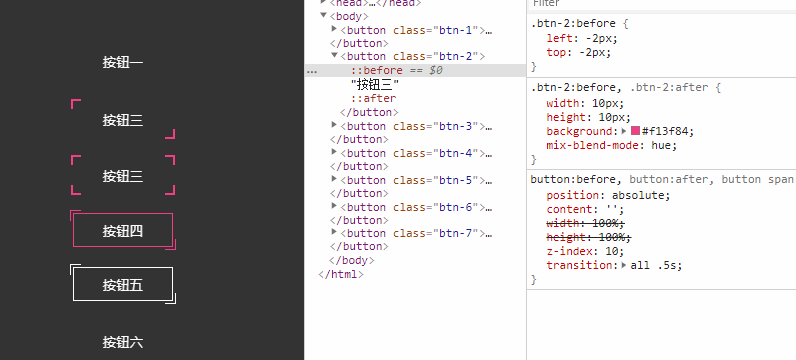纯CSS3实现鼠标滑过按钮动画第二节
脚本宝典收集整理的这篇文章主要介绍了纯CSS3实现鼠标滑过按钮动画第二节,脚本宝典觉得挺不错的,现在分享给大家,也给大家做个参考。
有了之前的两章,小伙伴们对按钮悬浮动画是否又有了新的认识呢?
前面两章主要是从背景着手,而本章主要是围绕边框动画做效果。并且,本章节(按钮组:有趣的CSS按钮动画,带你进入CSS世界)也就到此结束了,本章结尾会对前3小节进行一定的总结。
下面继续本小节的主题,请先看一下效果示例:

看过前两小节的小伙伴,可能不需要看下面的源码,就知道如何实现了,大家可以先自己动手试试,然后再回头来看看。或许实现方式不一样,但只要能实现,都是好方法。
示例一
<button class="BTn-1">按钮一</button> <style> button{ posITion: relative; width: 100px; height: 40px; background: none; cursor: pointer; color: #fff; border: none; m@R_406_2604@in-right: 20px; margin-bottom: 20px; } button:before, button:after{ position: absolute; content: ''; width: 100%; height: 100%; z-index: 10; transition: all .5s; } /* 按钮一 */ .btn-1:before, .btn-1:after{ height: 2px; left: 50%; width: 0; background: #F13f84; transform: translatex(-50%); } .btn-1:before{ top: 0; } .btn-1:after{ bottom: 0; } .btn-1:hover:before, .btn-1:hover:after{ width: 100%; } </style>

解析:
1、 :before top为0, :after bottom为0,高度 height: 2px ,而宽度为0,并且水平居中
2、在绝对定位的作用下, :hover 改变 :before 、 :after 的宽度,即可形成上图效果
示例二
<button class="btn-2">按钮二</button> <style> ... /* 这里省略上方的公共样式 */ .btn-2{ background: #333; height: 36px; } .btn-2:before, .btn-2:after{ width: 10px; height: 10px; background: #f13f84; mix-blend-mode: hue; } .btn-2:before { left: -2px; top: -2px; } .btn-2:after { right: -2px; bottom: -2px; } .btn-2:hover:before, .btn-2:hover:after{ height: calc(100% + 4px); width: calc(100% + 4px); } </style>

解析:
1、 :before 、 :after ,超出button 2px
2、 :hover 时改变 :before 、 :after 宽高,这里宽高用到了 calc()
calc() 函数用于动态计算长度值。
● 需要注意的是,运算符前后都需要保留一个空格,例如: width: calc(100% - 10px) ;
● 任何长度值都可以使用 calc() 函数进行计算;
● calc() 函数支持 "+", "-", "*", "/" 运算;
● calc() 函数使用标准的数学运算优先级规则;
3、大家应该都留意到了上图中,特意操作了一个属性 mix-blend-mode ,它在这里的作用让button的背景显示出来覆盖在 :before 、 :after 背景色的上方。
css3 mix-blend-mode 语法
mix-blend-mode:normal | multiply | screen | overlay | darken | lighten | color-dodge | color-burn | hard-light | soft-light | difference | exclusion | hue | saturation | color | luminosity
hue 色相模式 “色相”模式只用“混合色”颜色的色相值进行着色,而使饱和度和亮度值保持不变。
这里就不具体讲述 mix-blend-mode ,希望后面能用一章来专门讲解。
示例三
<button class="btn-3">
<span>按钮三</span>
</button>
<style>
...
/* 这里省略上方的公共样式 */
button span:before,
button span:after{
position: absolute;
content: '';
width: 100%;
height: 100%;
z-index: 10;
transition: all .5s;
}
.btn-3{
background: #333;
height: 36px;
}
.btn-3:before,
.btn-3:after,
.btn-3 span:before,
.btn-3 span:after{
width: 10px;
height: 10px;
background: #f13f84;
mix-blend-mode: hue;
}
.btn-3:before {
left: -2px;
top: -2px;
}
.btn-3:after {
right: -2px;
top: -2px;
}
.btn-3 span:before {
left: -2px;
bottom: -2px;
}
.btn-3 span:after {
right: -2px;
bottom: -2px;
}
.btn-3:hover:before,
.btn-3:hover:after,
.btn-3:hover span:before,
.btn-3:hover span:after {
height: 60%;
width: 60%;
}

解析:
1、示例三就是示例二的升级版,用span的伪类来完善按钮的四只角
2、 :hover 时改变四个伪类的宽高即可。
示例四
<button class="btn-4">按钮四</button>
<style>
...
/* 这里省略上方的公共样式 */
.btn-4{
height: 34px;
border: 1px solid #f13f84;
}
.btn-4:before,
.btn-4:after{
width: 10px;
height: 10px;
border-style: solid;
border-color: #f13f84;
}
.btn-4:before {
left: -4px;
top: -4px;
border-width: 1px 0 0 1px;
}
.btn-4:after {
right: -4px;
bottom: -4px;
border-width: 0 1px 1px 0;
}
.btn-4:hover:before,
.btn-4:hover:after{
height: calc(100% + 7px);
width: calc(100% + 7px);
}

解析:
1、示例四是示例二的另外一种实现方式,不过区别是按钮加了一个边框
2、 :before 、 :after 直接设置 border ,而不是用 background 来展示对角样式。
width: 10px; height: 10px; border-style: solid; border-color: #f13f84; border-width: 1px 0 0 1px;
3、然后 :hover 时改变伪类宽高,即可
示例五
<button class="btn-5">按钮五</button>
<style>
...
/* 这里省略上方的公共样式 */
.btn-5{
background: #333;
height: 34px;
border: 1px solid #fff;
}
.btn-5:before,
.btn-5:after{
width: 10px;
height: 10px;
border-style: solid;
border-color: #fff;
}
.btn-5:before {
left: -4px;
top: -4px;
border-width: 1px 0 0 1px;
}
.btn-5:after {
right: -4px;
bottom: -4px;
border-width: 0 1px 1px 0;
}
.btn-5:hover{
border-color: #f13f84;
}
.btn-5:hover:before,
.btn-5:hover:after{
height: calc(100% + 7px);
width: calc(100% + 7px);
border-color: #f13f84;
transform: rotateY(180deg);
}

解析:
1、示例五,与示例四只有2点区别, :hover 时,使其伪类旋转180°,同时改变边框颜色
border-color: #f13f84; transform: rotateY(180deg);
示例六
<button class="btn-6">
<span>按钮六</span>
</button>
<style>
...
/* 这里省略上方的公共样式 */
.btn-6{
overflow: hidden;
}
.btn-6:before,
.btn-6:after,
.btn-6 span:before,
.btn-6 span:after{
background: linear-gradient(to right, rgba(0,0,0,0), #f13f84);
transition: all 2s;
}
.btn-6:before,
.btn-6:after{
width: 100%;
height: 1px;
}
.btn-6:before {
top: 0;
left: -100%;
}
.btn-6:after {
bottom: 0;
right: -100%;
}
.btn-6 span:before, .btn-6 span:after{
width: 1px;
height: 100%;
}
.btn-6 span:before {
bottom: -100%;
left: 0;
}
.btn-6 span:after {
top: -100%;
right: 0;
}
.btn-6:hover:before{
animation: topA 1s linear infinite;
animation-delay: .5s;
}
@keyframes topA{
100%{
left: 100%;
}
}
.btn-6:hover span:after{
animation: rightA 1s linear infinite;
animation-delay: 1s;
}
@keyframes rightA{
100%{
top: 100%;
}
}
.btn-6:hover:after{
animation: bottomA 1s linear infinite;
animation-delay: 1.5s;
}
@keyframes bottomA{
100%{
right: 100%;
}
}
.btn-6:hover span:before {
animation: leftA 1s linear infinite;
animation-delay: 2s;
}
@keyframes leftA{
100%{
bottom: 100%;
}
}

解析:
1、示例六,可以说和示例三有一点点相似之处吧,升级版
2、也是通过四个伪类,分别分布在按钮的上右下左位置,上下的伪类高度是1px,宽是100%,左右的伪类宽度是1px,高是100%,同时设置背景为线性渐变 linear-gradient
3、 :hover 时,上方伪类从左边-100%的位置,向左边100%的位置运动;右边伪类从上方-100%的位置,向上方100%的位置运动;下发伪类从右边-100%的位置,向右边100%的位置运动;左边伪类从下方-100%的位置,向下方100%的位置运动。然后设置延时执行动画,即可。
需要注意的是延时执行动画(animation-delay)时间,一定要调整好,否则看起来就没有流畅,衔接会出现问题。
示例七
<button class="btn-7"> <svg height="100%" width="100%" XMlns="http://www.w3.org/2000/svg"> <rect class="outline" height="100%" width="100%" /> <div class="text">按钮七</div> </svg> </button> <style> ... /* 这里省略上方的公共样式 */ .btn-7{ position: relative; color: #f13f84; text-decoration: none; width: 250px; height: 50px; margin: 50px auto; overflow: hidden; } .btn-7 .outline { position: absolute; top: 0; left: 0; width: 100%; height: 100%; stroke: #f13f84; stroke-width: 2px; fill: transparent; stroke-dasharray: 100 500; stroke-dashoffset: 225; transition: all .5s; box-sizing: border-box; } .btn-7 .text { position: relative; top: -35px; line-height: 1; letter-spacing: 1px; text-transform: upPErcase; } .btn-7:hover .outline{ stroke-dasharray: 600 0; stroke-dashoffset: 475; }

解析:
1、示例七,是一种全选的方式,svg
2、svg 元素描述
<text> 元素用于定义文本
<rect> 定义为矩形形状(圆形 <circle> 、椭圆 <ellipse> 、线 <line> 、折线 <polyline> 、多边形 <polygon> 、路径 <path> )
3、svg 属性描述
stroke 定义一条线,文本或元素轮廓颜色
stroke-width 属性定义了一条线,文本或元素轮廓厚度
stroke-dasharray 属性用来设置描边的点划线的图案范式。就是设置实线和虚线的宽度。即有或者没有线段的长度。
stroke-dashoffset 则指定了dash模式到路径开始的距离
具体,后面也提供专门章节讲述
总结
本章节(按钮组:有趣的CSS按钮动画,带你进入CSS世界)到此就结束了,首先谢谢大家的支持。
通过本章节,小伙伴们都学到了什么?
1、思想,每个小节,示例都是从易至难,循序渐进;
2、CSS 伪类元素 :before 、 :after 的运用
3、htML元素的布局,元素水平垂直居中
4、 transition 和 animation 动画,它们有什么区别呢(想知道答案的可以看小编历史文章)?
5、CSS3 线性渐变和径向渐变
6、相对定位和绝对定位灵活运用
7、 transform 元素移动、变形、旋转等
脚本宝典总结
以上是脚本宝典为你收集整理的纯CSS3实现鼠标滑过按钮动画第二节全部内容,希望文章能够帮你解决纯CSS3实现鼠标滑过按钮动画第二节所遇到的问题。
本图文内容来源于网友网络收集整理提供,作为学习参考使用,版权属于原作者。
如您有任何意见或建议可联系处理。小编QQ:384754419,请注明来意。
- css怎么控制按钮不可用 2022-05-17
- css3中transform属性实现的4种功能 2022-04-13
- 纯CSS3实现div按照顺序出入效果 2022-04-13
- CSS实现隐藏搜索框功能(动画正反向序列) 2022-04-13
- 使用CSS3实现按钮悬停闪烁动态特效代码 2022-04-13
- CSS3 Tab动画实例之背景切换动态效果 2022-04-13
- CSS实现两列布局的N种方法 2022-04-13
- CSS 实现Chrome标签栏的技巧 2022-04-13
- css实现两栏布局,左侧固定宽,右侧自适应的多种方法 2022-04-13
- 从QQtabBar看css命名规范BEM的详细介绍 2022-04-13